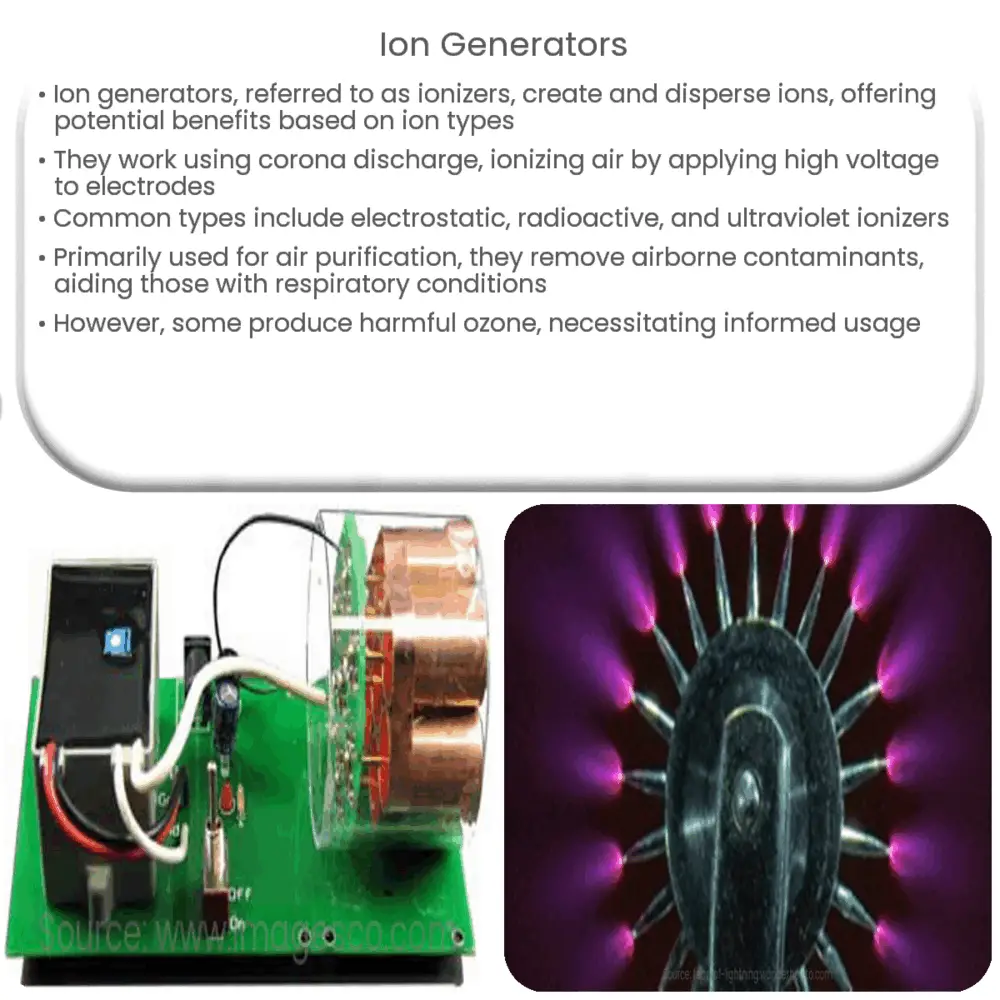Explore the world of ion generators: their working principle, types, applications, maintenance, and related health considerations.

Understanding Ion Generators
Ion generators, also commonly referred to as ionizers or negative ion generators, are devices that create and disseminate ions into the surrounding environment. This can have several potential benefits, depending on the type of ions being generated and their intended application.
Ions are atoms or molecules that have either lost or gained an electron. This alteration gives them a net positive or negative charge. In the context of ion generators, we generally talk about negative ions, denoted as anions. Anions are often associated with improved mood and physical health, though scientific opinions vary.
Working Principle of Ion Generators
Ion generators work by employing a process known as corona discharge, a phenomenon where an electric current is passed through a gas, ionizing it in the process. The core mechanism involves a high voltage being applied to a series of sharp electrodes. The high voltage causes the nearby air molecules to be ionized, effectively creating anions. These negatively charged ions are then dispersed into the surrounding environment.
Types of Ion Generators
- Electrostatic Ionizers: These are a common type of ion generator often found in air purifiers. They use high voltage to ionize air particles. The negatively charged particles are then attracted to a positively charged plate, thereby removing them from the air.
- Radioactive Ionizers: These ionizers use a small amount of radioactive material to ionize the air. While less common, they are occasionally used in smoke detectors.
- Ultraviolet Ionizers: Ultraviolet ionizers use UV light to ionize air. They are commonly used in sterilization processes, as the UV light can also kill bacteria and other microbes.
Applications of Ion Generators
The primary application of ion generators is in the field of air purification. By charging airborne particles, they can effectively remove contaminants and allergens from the air. This is particularly beneficial for individuals with allergies, asthma, or other respiratory conditions. They are also used in certain industries for static reduction and dust removal. Despite the wide range of applications, it’s essential to understand that there are potential risks associated with their use, particularly in relation to ozone production.
Note: Understanding Ozone Risks
While ion generators can be beneficial, they also have potential downsides. Most notably, some types can produce ozone as a byproduct. Ozone in the upper atmosphere is beneficial as it shields us from harmful UV rays. However, at ground level, it can be harmful if inhaled, potentially leading to a variety of respiratory problems. Therefore, it’s important to understand the type and nature of any ion generator before use.
Commercial Ion Generators
Commercially available ion generators are often designed with safety measures to limit ozone production. These devices, such as air purifiers and sanitizers, are equipped with filters or other methods to prevent ozone from being released into the environment. Nevertheless, it is crucial to verify that any ion generator purchased is compliant with safety standards and regulations.
Notable Research on Ion Generators
Research on ion generators has yielded interesting results, albeit with ongoing debate. Some studies suggest that negative ions can have a beneficial impact on mood and overall well-being. They are credited with increasing serotonin levels, improving sleep, and even boosting immune system functionality. Conversely, other studies find no significant impact, leading to divergent views on their effectiveness.
Choosing an Ion Generator
When selecting an ion generator, one should consider several factors. The first is the size of the space the device is intended for. Larger spaces may require a more powerful device or multiple devices. Another consideration is the type of particles the device is intended to remove, as different devices may be more effective against specific contaminants. Furthermore, the potential production of ozone should be a key deciding factor.
Maintenance of Ion Generators
Like any electronic device, ion generators require regular maintenance to ensure they continue functioning optimally. This includes cleaning and, if applicable, replacing filters. Electrostatic ionizers often feature collection plates that must be cleaned regularly to maintain efficiency. Users should always refer to the device’s user manual for specific maintenance instructions.
Conclusion
Ion generators represent a fascinating intersection of physics and practical, everyday applications. Whether it’s for air purification, mood enhancement, or industrial uses, these devices utilize the principle of ionization to provide potential benefits. However, the science behind their effectiveness is still under debate. Furthermore, potential health risks such as ozone production should be factored into any decision to use these devices. With a considered approach, ion generators can be a useful tool for improving our environment, but like any tool, they must be used with care and understanding.

